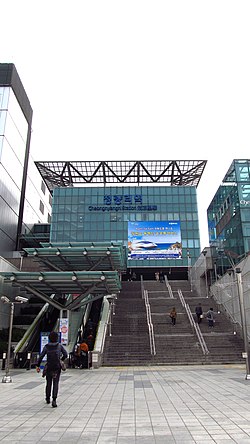Dongdaemun District
Dongdaemun
동대문구 | |
|---|---|
| 동대문구 · 東大門區 | |
 Korail Cheongnyangni station building | |
|
Sudogwon | |
| Special City | Seoul |
| Administrative dong | 14 |
| Government | |
| • Body | Dongdaemun-gu Council |
| • Mayor | Lee Pil-Hyeong (People Power) |
| • MNAs | List of MNAs |
| Area | |
| • Total | 14.22 km2 (5.49 sq mi) |
| Population (2010 Korea Standard Time) | |
| Postal code. | 02400~02699 |
| Area code | 02-900,2200 |
| Website | District Government |
 | |
Dongdaemun District (Korean: 동대문구, romanized: Dongdaemun-gu, "Great Eastern Gate") is one of the 25 districts of Seoul, South Korea.
Dongdaemun has a population of 346,770 (2010) and has a geographic area of 14.22
Dongdaemun is part of the
Yoo Deok-yeol (유덕열) of the Democratic Party has been the mayor of Dongdaemun since July 2010.
History
Dongdaemun District was first created in 1943 when the "gu" system started and was larger in area than it is today. Seongbuk District separated from the district in 1949, and Changsin Dong and Sungin Dong were given to Jongno District in 1975. An additional 17 dong (neighborhoods) separated to become Jungnang District in 1988.[2]
Administrative divisions

Dongdaemun District currently comprises 14 dongs.[3]
- Cheongnyangni-dong
- Dapsimni 1-dong
- Dapsimni 2-dong
- Hoegi-dong
- Hwigyeong 1-dong
- Hwigyeong 2-dong
- Imun 1-dong
- Imun 2-dong
- Jangan 1-dong
- Jangan 2-dong
- Jegi-dong
- Jeonnong 1-dong
- Jeonnong 2-dong
- Yongsin-dong
Transportation
Underground
- Korail and Seoul Metro
- Underground Line 1
- (Seongbuk-gu)
- (
- Underground Line 1
- Seoul Metro
- Underground Line 2
- (Yongdu − Sinseol-dong
- (
- Underground Line 2
- Seoul Metropolitan Rapid Transit Corporation
- Underground Line 5
- (Gwangjin-gu)
- (
- Underground Line 5
- Korail
- Jungang Section Line from Yongsan to Paldang
- (Jungnang-gu)
- (
There are more stations will add.
Geography
Dongdaemun District borders
Education
Universities
- University of Seoul
- Kyunghee University
- Hankuk University of Foreign Studies
Research
Attractions
- Gyeongdong Market
- Dongseo Market
- King Sejong Memorial
- Seoul City Cultural Asset: Seonnongdan (선농단 先農壇), King Sejong Sindobi (세종대왕신도비 世宗大王神道碑, monumental stone)
- National Treasure: Supyo (수표 水標)
- Historical Site: Yeonghuiwon (영휘원永徽園)[2]
The grave sites of
Sister cities
 Anguo, China
Anguo, China- Yanqing, China
 Shanghai, China
Shanghai, China New York City, United States
New York City, United States Los Angeles, United States
Los Angeles, United States Paris, France
Paris, France Lyon, France
Lyon, France London, England
London, England
References
- ^ Korean Statistical Information Service (Korean) > Population and Household > Census Result (2010) > Population by Administrative district, Sex and Age / Alien by Administrative district and Sex Archived 2013-08-26 at the Wayback Machine, Retrieved 2010-06-02.
- ^ a b c "동대문구 (Dongdaemun-gu 東大門區)" (in Korean). Doosan Encyclopedia. Retrieved 2008-04-16.[permanent dead link]
- ^ "Administrative District". Dondaemun-gu. Retrieved 2015-01-05.
External links
- Official site (in English)
